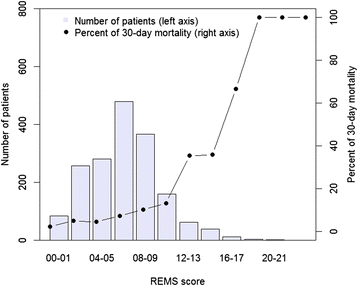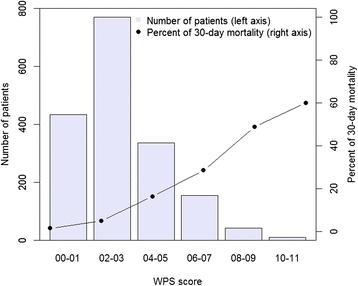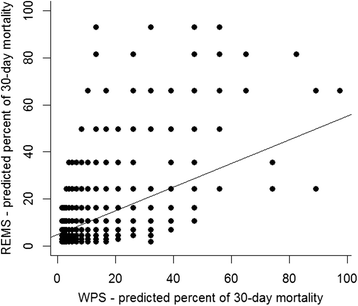Prognostic performance of the Rapid Emergency Medicine Score (REMS) and Worthing Physiological Scoring system (WPS) in emergency department
- PMID: 26069474
- PMCID: PMC4457731
- DOI: 10.1186/s12245-015-0066-3
Prognostic performance of the Rapid Emergency Medicine Score (REMS) and Worthing Physiological Scoring system (WPS) in emergency department
Abstract
Background: The Rapid Emergency Medicine Score (REMS) and Worthing Physiological Scoring system (WPS) have been developed for predicting in-hospital mortality in nonsurgical emergency department (ED) patients. The prognostic performance of the scoring systems in independent populations has not been clear. The aim of the study is to evaluate the prognostic accuracy of REMS and WPS systems in the estimation of 30-day mortality risk among medical patients in ED.
Methods: The study was designed as a prospective investigation, with the setting being the ED of the National Hospital of Can Tho, Vietnam. We enrolled medical patients aged 16+ years who met the study entry criteria. Clinical data were obtained as required for each scoring system. The primary outcome was mortality within 30 days since hospitalization. The association between each scoring system and mortality was assessed by the hazard ratio (HR) of the Cox's proportional hazard model.
Results: The study involved 1746 patients, average age 65.9 years (SD 17). During the period of follow-up, 172 patients (9.9 %) died. The risk of 30-day mortality was increased by 30 % for each additional REMS unit (HR: 1.28; 95 % confidence interval (CI): 1.23-1.34) and by 60 % for each additional WPS unit (HR: 1.6; 95 % CI: 1.5-1.7). The AUC of the REMS was 0.71 (95 % CI: 0.67-0.76) which was significantly lower than that of the WPS (0.80; 95 % CI: 0.76-0.83).
Conclusions: Both REMS and WPS have good prognostic value in the prediction of death in ED patients. The WPS appeared to have a better prognostic performance than the REMS system.
Keywords: Emergency department; Prognostic model; Rapid emergency medicine score; Worthing physiological scoring system.
Figures





References
-
- Duckitt RW, Buxton-Thomas R, Walker J, Cheek E, Bewick V, Venn R, et al. Worthing physiological scoring system: derivation and validation of a physiological early-warning system for medical admissions. An observational, population-based single-centre study. Br J Anaesth. 2007;98(6):769–74. doi: 10.1093/bja/aem097. - DOI - PubMed
LinkOut - more resources
Full Text Sources
Other Literature Sources
Miscellaneous

